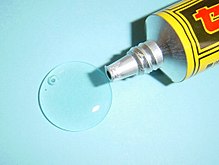Cellulose ester

Cellulose esters are derivatives of cellulose that are formed by esterifying the hydroxyl groups with acids. By changing the functional groups in the molecule, it is possible to change the properties of the cellulose. The cellulose for this is obtained from wood in a thermocatalytic process. Cellulose nitrates and cellulose acetates in particular are technically important today .
Historically, the age of plastics began, back then in the form of modified natural products, with cellulose nitrate. Cellulose nitrate as the oldest technical cellulose derivative is the basis of celluloid , which was produced by kneading this cellulose derivative with camphor as a plasticizer and ethanol .
properties
By derivatization of cellulose to products can produce completely different properties than the original product. An important property is the solubility in organic solvents. This depends strongly on the degree of esterification (how many hydroxyl groups are esterified). Other properties of the cellulose esters also depend on the type of substituents, the number of substituted hydroxyl groups and their distribution. An essential difference between cellulose nitrates and cellulose acetates is that cellulose nitrates tend to self-ignite and explode and burn without additional oxygen, whereas cellulose acetates are flame-retardant.
Manufacturing
The cellulose is mechanically broken down by shredding and grinding and then acid ( nitric acid or acetic acid ) is added, possibly with catalysis by sulfuric acid or other catalysts . The degree of esterification is u. a. determined by the concentration of the acid.
application
Cellulose acetates are processed in the form of fibers, films, granules or solutions. Typical areas of application are textiles, cigarette filters, lacquers and engineering plastics. A large part of the cellulose nitrates is used for the manufacture of explosives. In addition, they are used for varnishes and membranes and are used in special products such as combs or hair accessories.
Economical meaning
The market for cellulose derivatives (cellulose esters and cellulose ethers ) is estimated at over 100,000 t in Germany. Today the most important markets for cellulose nitrate are explosives and for cellulose acetate cigarette filters. As innovative biomaterials , cellulose esters are becoming increasingly important in various applications.
Individual evidence
- ↑ H.-P. Fink and S. Fischer: Cellulose processing - environmentally friendly technologies on the advance. Fraunhofer Institute for Applied Polymer Research.
literature
- P. Eyerer, P. Elsner, T. Hirth (Eds.): The plastics and their properties. 6th edition, Springer Verlag, Heidelberg 2005, ISBN 3-540-21410-0 , pp. 1443-1482.
- Hans-Josef Endres, Andrea Siebert-Raths: Technical biopolymers. Hanser-Verlag, Munich 2009, ISBN 978-3-446-41683-3 .
